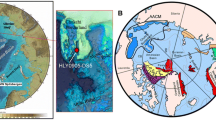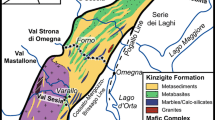Abstract
Internal structures in zircons from granitoids from the late Archaean Darling Range Batholith show secondary features revealed by HF etching, which record reconstitution of the zircons and modification of the distribution of trace elements during post crystallisation cooling of the granitoid. Zircons from the granites commonly contain unzoned to weakly zoned cores surrounded by rims showing oscillatory zoning which has been modified by recrystallisation. The most striking feature is the development of high trace element concentration areas found in zircons from a number of granites. These structures range from enhanced trace element concentrations in primary zones to a single accumulation of most trace elements in one band, about half way between the outer edge and the centre of the zircon. In any zircon the extent of the concentration of trace elements towards the formation of a single trace element band appears to be inversely related to the fading and broadening of primary oscillatory zones in the outer rim. This suggests that the trace element bands formed by migration of trace elements from the outer primary zones to new concentration sites on an inner set of primary zones. This explanation is supported by the formation of multiple curved trace element bands that transgress primary zoning and the determination of younger SHRIMP ages on depleted zircon outer rims compared to remnant primary oscillatory zoned areas of the zircon and unzoned centres. Also observed in some granite zircons is a finely convoluted zoning which overprints oscillatory zoning in parts of a zoned zircon and in rare cases occurs throughout the zircon. This structure is explained in terms of secondary migration and reconcentration of trace elements in curved bands. All structures can be transgressed by generally rounded lobes and patches of low U, weakly nebulously zoned zircon. This is interpreted as a late stage interaction between the zircon and fluids formed during cooling and crystallisation of the granitoid, resulting in recrystallisation of affected parts of the zircon with accompanying loss of trace elements from the zircon.
Similar content being viewed by others
Author information
Authors and Affiliations
Additional information
Received: 6 January 1998 / Accepted: 8 May 1998
Rights and permissions
About this article
Cite this article
Pidgeon, R., Nemchin, A. & Hitchen, G. Internal structures of zircons from Archaean granites from the Darling Range batholith: implications for zircon stability and the interpretation of zircon U-Pb ages. Contrib Mineral Petrol 132, 288–299 (1998). https://doi.org/10.1007/s004100050422
Issue Date:
DOI: https://doi.org/10.1007/s004100050422




